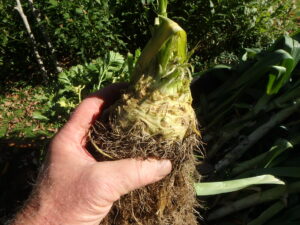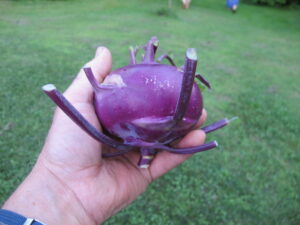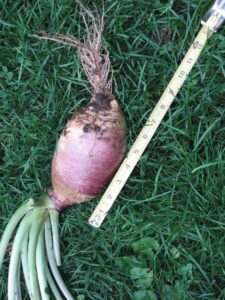It’s Not Too Late to Start Some Less Common Veggies
Posted on Tuesday, June 7, 2022 · Leave a Comment
It’s not too late to plant some more things in the vegetable garden. It’s only June, and there is still time. Here are some tips for some less commonly planted veggies – for growing and/or using. It’s way too late to start most things from seed, but you can sometimes buy started plants at a good local greenhouses or garden center.
Artichokes: These are big plants, so you need a two-foot wide square in good, rich, moist soil in full sun. You will get one good sized “choke” on the top of the plant, and a few more as side shoots. Grow them because the foliage and chokes are beautiful, even if not much food. They are nice in the flower garden, too.

Remove top leaves of Brussels sprouts to get bigger sprouts
Brussels sprouts: I get many emails complaining that the little green globes that we eat never get big. But that’s easy to fix: on Labor Day weekend, go to the garden with a sharp knife. Then, as the Red Queen of Alice and Wonderland said, “Off with their heads!” That’s right, slice off the top four inches or so of the plant and it will plump up the sprouts and stop putting all its energy into getting taller. They are incredibly frost hardy so you can harvest as late as Christmas if you wish.
Cauliflower: These guys are fussy. If they get too cold, too hot, too wet or too dry they will only produce a ”button” of a head. But if you’re lucky, you’ll get a mouth-watering delight. And they come in purple, too! But cooked, the purple turns gray – so use them in a salad where the purple will amaze your guests.

Cut away the fine roots of celeriac to expose the bulbous root used for cooking or salads
Celeriac: These are root crops related to celery, but easier to grow. My home grown celery was always stringy and attracted slugs, so I stopped growing it. But celeriac is easy – if you have soil that stays moist. They need lots of water. I usually start seeds indoors in March but forgot this year, so I just bought some plants in a 4-pack at my local nursery. Harvest late in fall to let them get as big as possible.
Kale is a favorite of the Birkenstock crew, but should be grown by everyone. Why? It’s a green vegetable that is easy to grow and, unlike lettuce or spinach, it freezes well. I blanch it, and freeze it in zipper bags to use in soups, stews and smoothies all winter. Your garden center may still have seedlings, but you could start some by direct seeding in the ground for a fall crop. Each plant needs about 16 inches of space, so if starting from seed, plant several seeds in a group at that spacing, and then thin our all but one after they germinate.

Kohlrabi
Kohlrabi: These are in the cabbage/broccoli family but are an above-ground root (actually an enlarged stem). The leaves pop out of the purple or light green above-ground sphere. Some should be harvested at the size of baseballs, others are still perfect when the size of a duckpin bowling ball. The seed packet will tell you which you have. They taste a bit like broccoli and can be used raw in salads or cooked in a stir fry or soup. Some like ‘Gigante’ will store for 6 months in a cool cellar or fridge. These grow fast, so you can plant seeds now.
Parsnips I usually plant by seed around June 15 because they won’t germinate in cold soil. Seeds only are good for one year, so share the seed packet with your neighbor. Us “older folks” love parsnips. Parsnips grow like carrots, but get bigger. I leave them in the ground all winter, and harvest them the first thing in the spring. I steam them and serve them with butter and (real) maple syrup (of course).
Pole beans: Unlike bush beans, they keep on producing all summer if you keep on picking them. ‘Kentucky Wonder is the classic, but the tastiest I’ve eaten in ‘Kwintus’, which is still good when picked big. Kwintus seeds are hard to find, but I see they are available from Fedco Seeds.

Rutabagas get big and keep well
Rutabagas: Why do people never raise their hand when I ask a group, “Other than me, who has grown these gems? “ I admit, it’s an old fashioned vegetable, one our grandparents grew. But it’s easy to start from seed, it’s tasty and produces a lot food. Use it just like potatoes in a stew. Its advantage is that it won’t crumble and fall apart after re-heating the stew a few times. And potato beetles aren’t a problem. Just thin them to four inches apart and you will get roots bigger than any of your potatoes. Start by seed now.
Swiss chard is actually the same species as beets, but has been selected for big leaves, not big roots. Plant by seed (or plants if you can find them) now. Bedrock Gardens in Lee, NH (one of New England’s quiet gems) used purple-leafed ones in their garden last year (or was that a purple-leafed beet?). ‘Bright Lights’ Swiss chard offers stems in red, purple, yellow, orange and green. Plant them in the flower garden, eat them raw or steamed.
Tomatillos are used in Mexican dishes and can be grown here. But you need two plants to get proper pollination. I didn’t know that and only planted one the first time I tried it. It made fruit capsules, but with nothing inside! Look for plants at your local greenhouse.
Thank you, John Lenat (1888 to 1967), my maternal grandfather. You not only taught me how to make a good compost pile, you taught me the joy of eating fresh vegetables only minutes after picking them. I am eternally grateful.






